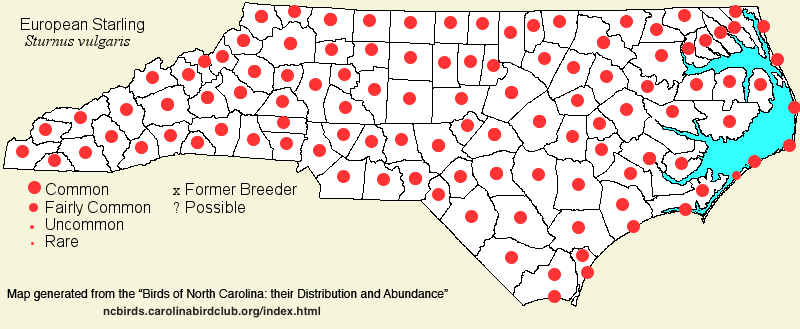 |  |
|
European Starling - Sturnus vulgaris Sole representative of STURNIDAE in NC | Search Common: Search Scientific: |
|
|
|||||||
| General Comments | This non-native species -- a native of the Old World -- was unfortunately introduced in New York City in 1890. Of course, the European Starling has spread across most of the continent and has been abundant in most areas, typically in cities, towns, and farmyards, for many decades. According to Pearson, Brimley, and Brimley's Birds of North Carolina (rev. ed. 1959), it was first seen in the state in Pender on 19 Dec 1919, and next seen at Manteo (Dare) and other places in 1922. This reference book states that they were first noted in the Piedmont at Raleigh on 19 Apr 1923. Because starlings nest in cavities, not constructed by themselves, they have had a negative impact on a handful of native bird species that nest in cavities, such as the Red-headed Woodpecker. Starlings join blackbirds in huge roosts in winter; at times in the state, these roosts may number over a million birds. Though numbers seem to have leveled off in the past few decades, they still remain too abundant for nearly all birders and non-birders alike. | ||||||
| Breeding Status | Breeder; Introduced | ||||||
| NC BRC List | Definitive | ||||||
| State Status | |||||||
| U.S. Status | |||||||
| State Rank | SE | ||||||
| Global Rank | G5 | ||||||
| Coastal Plain | Permanent resident. Abundant across the region, at all seasons. Gathers into huge roosts in winter. Peak counts: | ||||||
| Piedmont | Permanent resident. Abundant across the region at all seasons, except less numerous in the foothills. Peak counts: | ||||||
| Mountains | Permanent resident. Very common to abundant at all seasons in the lower elevations, to about 3,000 feet; less common at higher elevations, and thankfully scarce above about 5,000 at all seasons. Peak counts: | ||||||
| Finding Tips |
None needed. **** | ||||||
| Attribution | LeGrand[2018-02-01], LeGrand[2012-09-27], LeGrand[2011-12-12] | ||||||
| NC Map Map depicts all counties with a report (transient or resident) for the species. | Click on county for list of all known species. |
| NC Breeding Season Map Map depicts assumed breeding season abundance for the species. |  |